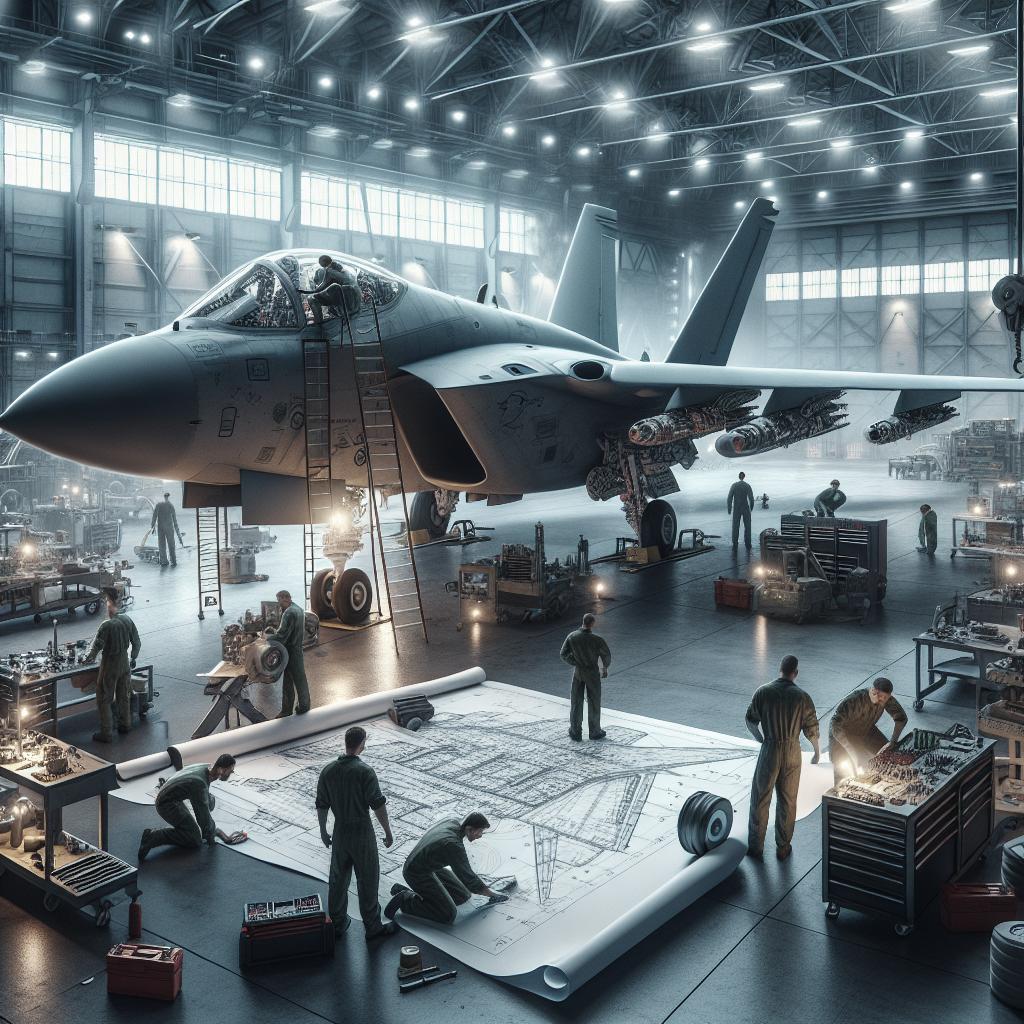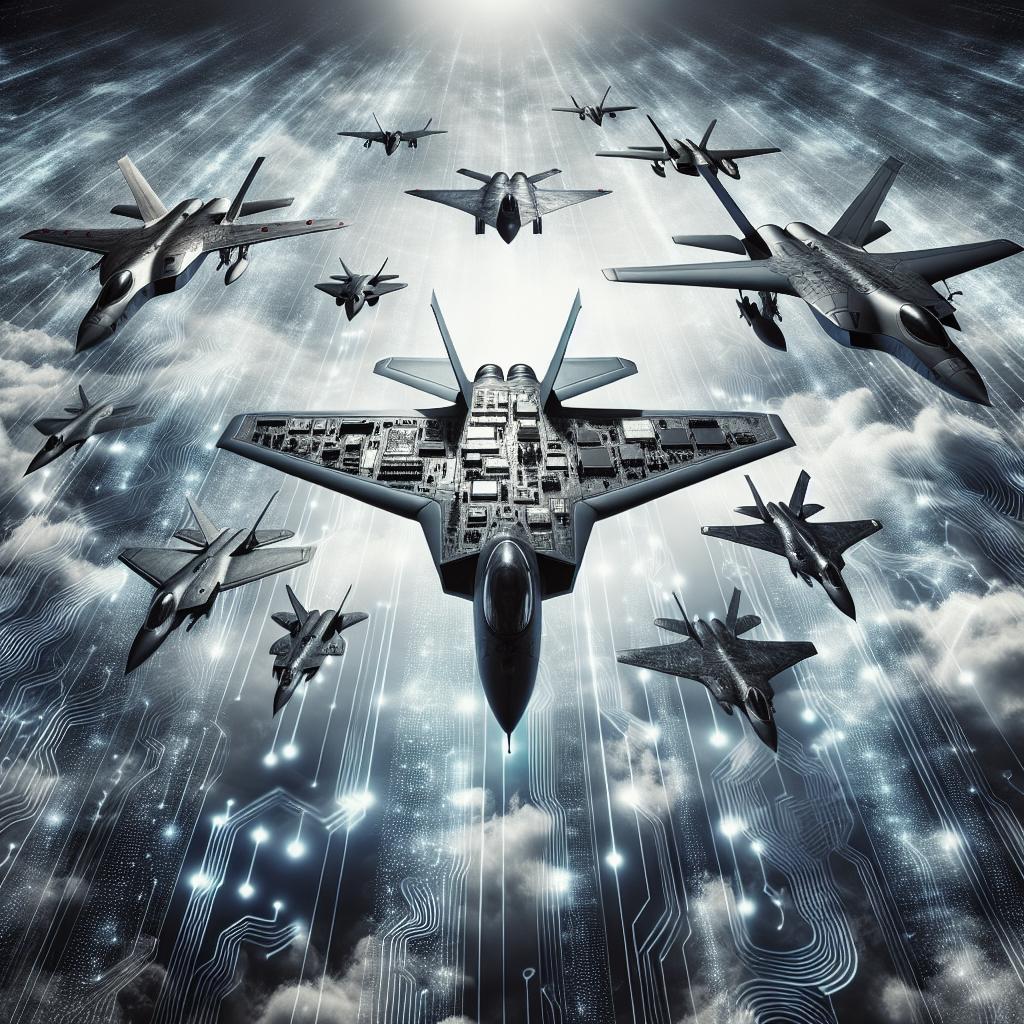### Maintenance Challenges for Military Planes: In-Depth Analysis Maintaining military planes is a high-stakes and complex endeavor shaping national security and defense readiness. Navigating through the intricacies of aviation maintenance, this article delves into specific challenges faced by the sector. From severe personnel shortages to technological disruptions and regulatory hurdles, we analyze pivotal factors straining the industry. We also explore strategies to address these issues, such as workforce development, economic considerations, and global event impacts. By examining solutions like national awareness campaigns, certification ease, and retirees’ involvement, we propose a holistic approach. Detailed insights into leveraging technology responsibly and fostering industry-regulatory collaboration round out this comprehensive look at military aviation maintenance. — ####
A Brief Overview Of Aviation Maintenance Challenges
####
How it works
Military aviation maintenance is a multifaceted and time-sensitive arena. The process entails regular inspections, repairs, and upgrades to ensure aircraft are combat-ready and operate safely. Key elements include routine checks, unscheduled repairs due to wear and tear, and modifications to integrate new technology or enhance capabilities. Units dedicated to maintenance work around the clock to keep fleets operational, often under tight schedules and challenging conditions. Each military aircraft, from stealth jets to transport helicopters, has unique maintenance requirements that demand specialized knowledge and tools. The work involves meticulous planning and execution, often following stringent protocols to adhere to safety and performance standards. Ground crews, engineers, and technicians collaborate closely, leveraging sophisticated diagnostics and repair equipment. — ####
The Heart of the Crisis
The heart of the crisis in military aviation maintenance lies in the convergence of several pressing issues. These include aging aircraft, budget constraints, and increased operational demands. Many military fleets are grappling with antiquated planes that require more frequent and intensive maintenance, placing added pressure on already stretched resources. Compounding these challenges is the ever-evolving nature of military operations which necessitates rapid deployment and adaptability. Maintenance teams must work under pressure, often in hostile environments, ensuring planes are ready for unpredictable missions. This situation strains personnel and resources, creating a backlog of maintenance work and risking operational readiness. — ####
Challenges in Modern Aviation Maintenance
Modern aviation maintenance faces a slew of challenges driven by technological advancements, global movements, and operational dynamics. One notable challenge is integrating new technologies into existing aircraft. Such upgrades often require significant reconfiguration and retraining of personnel, adding to the already substantial workloads. Additionally, the complexity of contemporary aircraft has surged, introducing more sophisticated systems that demand specialized maintenance expertise. Keeping up with these requirements is a continuous struggle, especially for older fleets still in operation. Moreover, the industry must contend with stringent regulations aimed at ensuring safety, often complicating maintenance procedures further. — ####
Severe Personnel Shortages
The aviation maintenance industry is facing a significant workforce shortfall, particularly acute in the military sector. There is a dire need for skilled technicians and engineers capable of performing the complex tasks necessary to maintain and repair advanced aircraft. This shortage is exacerbated by an aging workforce nearing retirement without sufficient new talent coming in to fill the gaps. Recruiting and retaining qualified personnel is increasingly challenging. The demanding nature of the job, coupled with competition from commercial aviation and other industries, means that the military struggles to attract young professionals. The gap between personnel needs and availability risks compromising maintenance quality and aircraft readiness. — ####
Technological Disruption vs. Workforce Skills
Technological advancements in aviation are a double-edged sword. On one hand, innovations such as predictive maintenance and digital twins promise to enhance efficiency and reduce downtime. On the other, the current workforce frequently lacks the skills necessary to harness these technologies effectively. Bridging this skills gap requires significant investment in training and education. Current personnel must be upskilled to handle new tools and systems, while fresh recruits need to be educated in both traditional maintenance techniques and cutting-edge technologies. Balancing this transition within a framework that ensures constant readiness of military planes is a formidable challenge. — ####
Regulatory Challenges
Regulations play a crucial role in ensuring the safety and reliability of military aircraft. However, complying with these regulations can be burdensome. Maintenance crews must navigate a labyrinthine set of guidelines and standards, often differing between national and international contexts. These regulatory requirements can extend the time needed for maintenance processes, impacting aircraft availability and mission readiness. The costs associated with compliance are also significant, diverting resources that could otherwise be used to enhance maintenance capabilities. Agencies must find a delicate balance between stringent safety measures and operational efficiency. — ####
Complexity of New Aircraft Models
The latest generations of military aircraft come with a host of advanced technologies, including stealth capabilities, sophisticated avionics, and complex weapon systems. These features, while enhancing operational capabilities, also make maintenance more intricate and challenging. Technicians must be proficient in these advanced systems to perform effective maintenance and repairs. Continuous learning and adaptation are required as new models are introduced, and existing ones are updated with next-gen technology. This constant learning curve poses a challenge for maintenance teams already spread thin. — ####
Economic Pressures and Cost Challenges
Economic factors exert a significant impact on military aviation maintenance. Budget constraints often mean that funds for maintenance are limited, even as operational demands increase. The expense of maintaining aging fleets adds another layer of financial strain, as older aircraft require more frequent and costly repairs. Moreover, the costs associated with new technologies and compliance with increasingly stringent regulations further exacerbates the financial challenges. Budget cuts can lead to deferred maintenance, creating a cycle of diminished aircraft readiness and escalating future costs. — ####
Impact of Global Events
Global events such as geopolitical tensions, natural disasters, and pandemics have far-reaching effects on military aviation maintenance. During times of crisis, the demand for rapid deployment of military aircraft increases, putting extraordinary strain on maintenance teams. These events can also disrupt supply chains, leading to shortages of essential parts and equipment. Additionally, global events often shift national priorities and resource allocations, sometimes resulting in reduced funding for maintenance operations. Such changes add another layer of complexity and uncertainty for maintenance crews, complicating their ability to ensure aircraft readiness and operational capability. — ####
Seeking Solutions and Mitigating Strategies
Addressing the myriad challenges in military aviation maintenance requires a multifaceted approach. Recognizing the need for systemic change is the first step. Strategies must be developed to mitigate impacts, focusing on workforce development, technological integration, regulatory reform, and economic management. Engaging in industry collaboration, creating robust policy frameworks, and fostering innovation are pivotal. By implementing comprehensive strategies, the industry can begin to tackle these challenges effectively, sustaining aircraft readiness and enhancing national security. — ####
Addressing the Workforce Gap
The personnel shortage is one of the most pressing issues in military aircraft maintenance. To address this, a multipronged approach is necessary. This includes increasing awareness of career opportunities within the military aviation sector and improving the working conditions and compensation for maintenance personnel. Training and development initiatives should be prioritized, ensuring that current staff are well-versed in new technologies and methodologies. Additionally, implementing policies that streamline the transition of veterans into maintenance roles can harness a valuable pool of experienced individuals. — ####
1. National Awareness Campaigns
National awareness campaigns play a crucial role in attracting new talent to military aviation maintenance. Highlighting the importance and rewards of a career in this field can inspire a new generation to pursue this path. Outreach can be done through schools, vocational programs, and media campaigns. Such campaigns should focus on dispelling myths and emphasizing the advanced technical skills and job security offered by this career. Collaborations with educational institutions can further develop specialized curricula aligned with military aviation maintenance needs. — ####
2. Building Instructional Capacity
Building stronger instructional capacity is essential for equipping future aviation technicians with the right skills. This means heightened investment in educational infrastructure, curriculum development, and instructor training. Partnerships between the military, educational institutions, and industry can facilitate this process. Modernizing training programs to incorporate new technologies and practices will ensure that recruits are adequately prepared for the complexities of contemporary aircraft maintenance. Practical, hands-on experiences must be integrated with theoretical knowledge to provide a well-rounded educational experience. — ####
3. Sensible Immigration Policies and Veteran Transitions
Immigration policies can play a pivotal role in addressing the personnel shortage. Recruiting skilled individuals from abroad can fill immediate gaps while long-term solutions are developed. Similarly, creating structured pathways for veterans to transition into maintenance roles can leverage their existing experience and skills. This approach requires policies that recognize and validate certifications and qualifications obtained abroad or in military service. Streamlining these processes will make it easier for qualified individuals to enter the workforce quickly and efficiently. — ####
4. Facilitating Certification Processes
The certification process for aviation maintenance personnel can be time-consuming and complex. Simplifying and accelerating these processes can help address the workforce gap more rapidly. Regulatory bodies must work towards reducing bureaucratic barriers without compromising safety and technical standards. Innovative approaches such as online certification programs and modular training can make the process more accessible. By making certification more attainable, more individuals can be encouraged to enter the field and fill critical roles. — ####
5. Retiree Involvement in Training
Retired military maintenance personnel represent a valuable resource of knowledge and experience. Engaging retirees as trainers or mentors can enhance the instructional capacity and provide new technicians with insights that only come from hands-on experience. This approach also allows retirees to continue contributing to national security efforts while sharing their expertise. Structured programs that facilitate this exchange can enrich the learning environment and build a more robust, skilled workforce. — ####
6. Investment in Training and Development
Continuous investment in the training and development of aviation maintenance personnel is critical. This includes not just initial training but ongoing professional development to keep pace with technological advancements and industry changes. Funds must be allocated for advanced training programs, simulation technologies, and continuing education opportunities. By fostering a culture of learning, the military can ensure that its maintenance teams are always at the forefront of technological and procedural improvements. — ####
Leveraging Technology Responsibly
While technological advancements offer substantial benefits, they must be leveraged responsibly. This means ensuring that maintenance teams are adequately trained in new technologies and that these tools complement rather than complicate existing workflows. Implementing predictive maintenance systems and utilizing advanced diagnostic tools can streamline processes and reduce downtime. However, it’s essential to balance technology adoption with practical, on-the-ground expertise to ensure optimum results. — ####
Industry and Regulatory Collaboration
Collaboration between industry players and regulatory bodies is vital for addressing the challenges in military aviation maintenance. By fostering open communication and joint problem-solving, stakeholders can develop standards and practices that enhance safety and efficiency while minimizing bureaucratic hurdles. Joint initiatives can focus on areas such as research and development, standardization of training programs, and harmonization of regulatory requirements. Such collaborative efforts can pave the way for more innovative, efficient, and effective maintenance practices. — ###
Final Thoughts
Addressing the multifaceted challenges in military aviation maintenance is essential for maintaining a robust and ready aircraft fleet. By focusing on workforce development, regulatory reforms, technological integration, and financial management, we can mitigate these issues. Collaboration among industry stakeholders, regulatory bodies, and educational institutions will play a pivotal role in devising sustainable solutions. —
| Challenge | Detail | Suggested Solutions |
|---|---|---|
| Severe Personnel Shortages | Shortage of skilled technicians and engineers. | National awareness campaigns, boosting educational capacity, sensible immigration policies, and veteran transitions. |
| Technological Disruption vs. Workforce Skills | Workforce lacks skills for new technologies. | Investing in training and development, simplifying certification processes. |
| Regulatory Challenges | Burdensome regulations complicate maintenance tasks. | Industry and regulatory collaboration. |
| Complexity of New Aircraft Models | Advanced technology requires specialized skills. | Continual upskilling, retiree mentorship programs. |
| Economic Pressures and Cost Challenges | Budget constraints impact maintenance quality. | Optimizing resource allocation, leveraging technology responsibly. |
| Impact of Global Events | Disruptions from geopolitical tensions and crises. | Flexible policy frameworks, robust contingency planning. |


